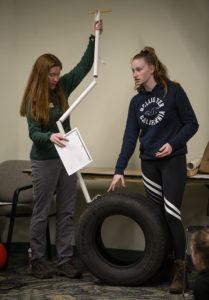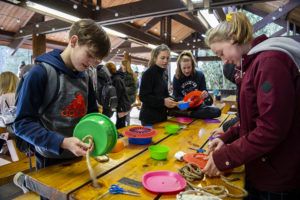Northwest Trek Wildlife Park recently became the classroom for local middle school students. Northwest Trek’s education experts created lesson plans about the different types of enrichment the animals can receive for the students from Columbia Crest A-S.T.E.M Middle School in Ashford.
Animal enrichment is an important part of animal care. It creates a more stimulating environment for the animals while encouraging natural behaviors. The keeper staff at Northwest Trek provide a variety of enrichment that challenge the animals both physically and mentally.
In February, Jessica Moore, the Education Curator at Northwest Trek, visited the Columbia Crest students in their classroom. She taught them all about enrichment and why it’s important.
“There are five different types of animal enrichment, including social, food, environmental, sensory and manipulative/toy enrichment,” said Moore. “Enrichment can include things like scents, puzzles, sounds or foraging challenges.”
The students came to Northwest Trek after their lesson to learn about the individual animals, see their habitats and see some of what we provide for them on a daily basis. From there, they got their homework and started designing their enrichment items.
Students got to work researching the animals and drawing their designs. Their designs were then sent off to the professionals- the people who work every day with the animals at Northwest Trek.
“These designs are really impressive but I do see a few opportunities to make improvements,” said Northwest Trek Zoological Curator, Marc Heinzman. “We need to make sure the enrichment is safe for the animals here at the park.”
With Heinzman’s comments in consideration, the students rummaged through their parents’ garages looking for items, like PVC pipe and rope, to bring the enrichment from the paper into creation.
After weeks of crafting, it was time for the real test.
In early March, the students hopped on a bus to Northwest Trek, enrichments in hand.

Moore, Heinzman and keeper Nicole Hennigan welcomed the 55 teenagers to the park. Gathered together in a room, they assessed each enrichment one-by-one.
“This puzzle feeder for the river otter looks great. I love the thick PVC pipe. But does it float? We don’t want it to sink to the bottom of their pool,” said Heinzman.
Students nodded in reassurance they’d tested it to make sure it floated.
“The end of these zip ties will be too sharp for the raccoons,” said Hennigan about another project. “It’s a good size and idea, but we don’t want them to cut their hands.”
Another group of students stood up to present their item.
“This is a puzzle feeder for a lynx. The top screws off so you can put food in there for them. Oh, and it’s non-toxic paint!” the leader of the group enthusiastically stated.
“This enrichment is perfect. Simple projects are sometimes the best, because they’re easy for staff to give the animals,” said Heinzman. “It’s also very tough so it would be hard for the lynx to break it and it’d be a challenge that would stimulate their brains.”
There were other projects too: a puzzle feeder filled with ice cubes for a wolverine, wiffle balls filled with mealworms for the ducks or skunks, a camouflage bucket to hide food in, and two tires for various animals to climb on.
“Great job today to all the groups! How about we all create enrichment items together now with the keepers?” said Moore.
The students excitedly moved outside, where keeper Miranda Mauck had set up six crafting stations.
“Choose a station!” said Moore. “You can make a snuffle mats for the ducks, poof balls for the snakes, paper chains, painted shamrocks, paper mache, or stuff coin wrappers.”

Keepers walked round, helping the students and explaining to them the importance of each enrichment.
“Raptors love to shred paper. They will be excited to play with the paper chains,” said Hennigan.
To complete the field trip, keepers chose some of the best group projects to give to the animals.
The bobcat was given a puzzle feeder, filled with frozen rabbit. Students quietly watched, as to not scare off the bobcat, as he sniffed his new enrichment. The raccoons were given a big orange ball and rolled it all around their exhibit. The badgers were given a puzzle feeder filled with tissue and food.
“This is the second year these students have done this field trip and seeing the progress in their projects from last year to this year is very impressive,” said Moore. “The animals and the keepers both appreciate all the hard work they’ve put in!”